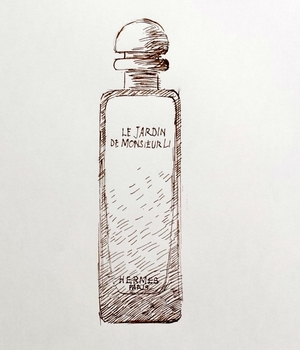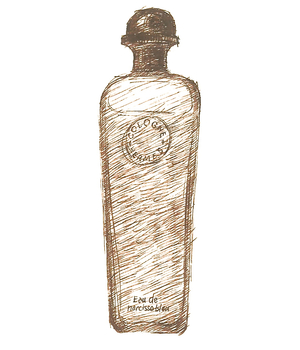Tagged With ‘green’
Hermès
Le Jardin de Monsieur Li
4 March, 2015
 The latest addition to the ‘Jardin’ range of perfumes from Hermès takes China as its inspiration, though apparently the original intention was to develop a fragrance inspired by English gardens. Sadly it seems that Jean-Claude Ellena, the company’s starry in-house perfumer, found the idea too conventional and boring, responding to the suggestion with words to the effect of ‘who wants to smell another rose garden?’
The latest addition to the ‘Jardin’ range of perfumes from Hermès takes China as its inspiration, though apparently the original intention was to develop a fragrance inspired by English gardens. Sadly it seems that Jean-Claude Ellena, the company’s starry in-house perfumer, found the idea too conventional and boring, responding to the suggestion with words to the effect of ‘who wants to smell another rose garden?’
If that’s true I think it’s a shame, since English gardens are some of the most varied and imaginative in the world, and I’d have loved to get the chance to show Ellena the all-green garden at Rousham, say, or the vast yew terraces of Powis Castle. Then again, perhaps he simply fancied travelling somewhere more exotic than could be reached within the limits of a day-trip on the Eurostar.
Either way, Chinese gardens, with their long and literary history, offer rich material for a creative perfumer, and it can’t hurt that China is a vast and expanding market for luxury brands, as attested by Hermès’ sumptuous new store in Shanghai.
Though the Monsieur Li of the title is imaginary, Ellena’s visits to Chinese gardens were made with the Chinese painter Li Xin, who moved from Beijing to Paris in 2002 and whose work forms a perfect counterpoint to Ellena’s: subtly sophisticated abstract ‘landscapes’ in washes of ink on creased rice-paper, one of which decorates the box for Le Jardin de Monsieur Li.
‘So,’ Hermès tell us, ‘Jean-Claude Ellena travelled to China. He visited gardens. Many gardens. Each one was unique but they all spoke the same language of fluidity and precision. So he created his own garden. An imaginary place inspired by the symbolic power of all the gardens he had seen. An earthly paradise in miniature, on a human scale. A retreat in which to converse with oneself and with others, and to honour one’s ancestors…
‘A vantage point from which to observe the soul and creation, where different kinds of beauty never compete but rather complement and enhance one another. A place that can only be fully experienced if one takes a partial tour of it every day, humbly and eagerly, with an eye that is ever fresh and a heart that is ever pure.’
If you’re feeling slightly queasy by now join the club, though this is par for the course for perfume PR. It probably sounds just fine in French, but high-flown purple prose translates terribly into Anglo-Saxon English, and I do wish they wouldn’t bother.
All the same it’s interesting to read what Ellena says about the smells that inspired him when he started work on Le Jardin de Monsieur Li at his house in Cabris near Grasse. ‘I remembered the scent of the pools, of the jasmine, the wet stones, the plum trees, the kumquats and the giant bamboo. It was all there, even the carp in their pond, taking the time to live to a hundred. The Sichuan pepper bushes were as thorny as roses and the leaves gave off a lemony scent.’
And can you smell this in the perfume itself? The answer is yes and no. I can certainly smell lemon and something like kumquats – a sweet, slightly strawberryish smell, though far less sweet than the delirious strawberry-kumquat scent of Black XS for Men from Paco Rabanne. I get a hint of jasmine, but it’s subtle and restrained enough for Le Jardin de Monsieur Li to be equally intriguing on a woman or a man.
It smells quite green and fresh to me as well, which I guess suggests the giant bamboo; Hermès describe the perfume’s ‘key notes’ as ‘Jean-Claude Ellena’s personal evocation of Vegetal Jasmine, Mint, Kumquat and Sap’.
What I like about this perfume most might drive other people mad, which is that I can’t quite put my finger on what it smells of, but to me that’s intriguing enough to make me want to keep wearing it. And though it’s subtle and restrained, Le Jardin de Monsieur Li has a staying power that some of Ellena’s other perfumes lack – worth noting when a 100ml bottle costs £84. Still, it’s a lovely scent and a beautiful bottle too, in heavy glass suffused by a pale shade of imperial yellow that delicately deepens from top to bottom.
Hermès
Eau de Narcisse Bleu
10 October, 2014
 Pretty much everyone I know loves Hermès’ deliciously fresh and zingy Eau d’Orange Verte, so when Eau de Narcisse Bleu (literally ‘blue narcissus water’) was launched in 2013 it had a tough act to follow. As I’ve never seen a blue narcissus / daffodil, I think it’s safe to say that this perfume has an element of fantasy about it, and as a smell, too, it’s perhaps rather more complex and a little less instantly accessible than its predecessor. But give it a little time and I think it’ll grow on you.
Pretty much everyone I know loves Hermès’ deliciously fresh and zingy Eau d’Orange Verte, so when Eau de Narcisse Bleu (literally ‘blue narcissus water’) was launched in 2013 it had a tough act to follow. As I’ve never seen a blue narcissus / daffodil, I think it’s safe to say that this perfume has an element of fantasy about it, and as a smell, too, it’s perhaps rather more complex and a little less instantly accessible than its predecessor. But give it a little time and I think it’ll grow on you.
Eau de Narcisse Bleu may not have the euphoric mood-lifting freshness of Eau d’Orange Verte, but it has a gentle softness that, once you’ve smelled it for a while, is extremely appealing in its own right. It does have the faint sweetness of real daffodil flowers (try sticking your nose in one on a sunny day next March and you’ll see what I mean), but what narcissus extract smells of most, rather unexpectedly, is fresh hay. *
Now, I have nothing against smelling of hay, which is a lovely scent in its own right, but what Hermès’ much-mythologised perfumer, Jean-Claude Ellena, has done is blended the smell of hay with a whole raft of subtly complementary fragrances. Most of them are quite ‘green’ – that is, they smell fresh and natural, like grass and leaves, but not especially sweet or flower-like.
To me it has a slight but definite scent of fig-leaves, which for anyone who loves L’Artisan Parfumeur’s wonderful Premier Figuier as much as I do can only be a good thing. Whether this figginess is (excuse the pun) a figment of my imagination I’m not sure, but among the other ingredients that Ellena lists is galbanum, which is extracted from the root of a wild Iranian plant that looks a bit like fennel or cow-parsley, and indeed is distantly related to them.
Galbanum has a marvellously fresh sappy smell like newly-snapped pea-pods, and is one of the most important components of ‘green’ perfumes, but its greenness, here, is tempered by the hay-like sweetness of narcissus, with a hint of earthy bitterness underneath which manages to stop it from smelling at all girly.
If my description makes it sound a bit complicated, don’t be put off, for it’s such a well-blended perfume that there’s nothing discordant about it. In fact if anything it is, perhaps, a little too gentle for its own good, as it’s a ‘quiet’, thoughtful scent that stays close to your skin and doesn’t, on the whole, grab other people’s attention. It’s discreet and refined, in other words, rather than a ‘look-at-me’ perfume, which is perfect if you want to smell good without drawing attention to yourself. Go try it.
* I say ‘narcissus extract’, but one of the irritating things about perfume marketing is how vague – and frankly clueless – most descriptions of perfume ingredients actually are. For as anyone who actually grows the things themselves knows full well, a bright-yellow daffodil like Narcissus ‘February Gold’ smells very different to Narcissus papyraceus, the so-called paperwhite narcissus; the former has a gentle, hay-like scent, while one of the big selling-points of paperwhites is their powerful, almost jasmine-like perfume, the sweetness of which, en masse, can have a touch of the slightly repellent stagnant-water smell that perfumers refer to as ‘indolic’. If only perfume PRs were taught some basic botany.
Postscript – mystery solved, but only by going to the source: in France last week I visited IFF-LMR, the legendary natural raw perfume materials company near Grasse, and what should we get talking about but their narcissus extract, which is derived from the beautiful Narcissus poeticus, fields of which grow wild in the uplands of the Lozère. Did they use other species of daffodil as well? No, came the answer, and it’s their extract that you’re smelling (among many other things) in Eau de Narcisse Bleu.